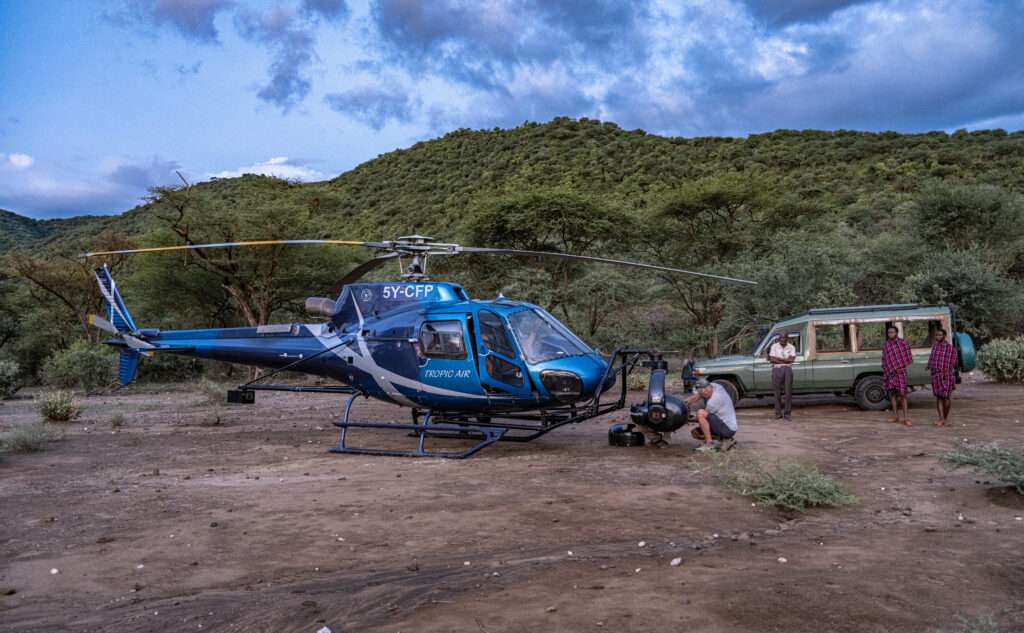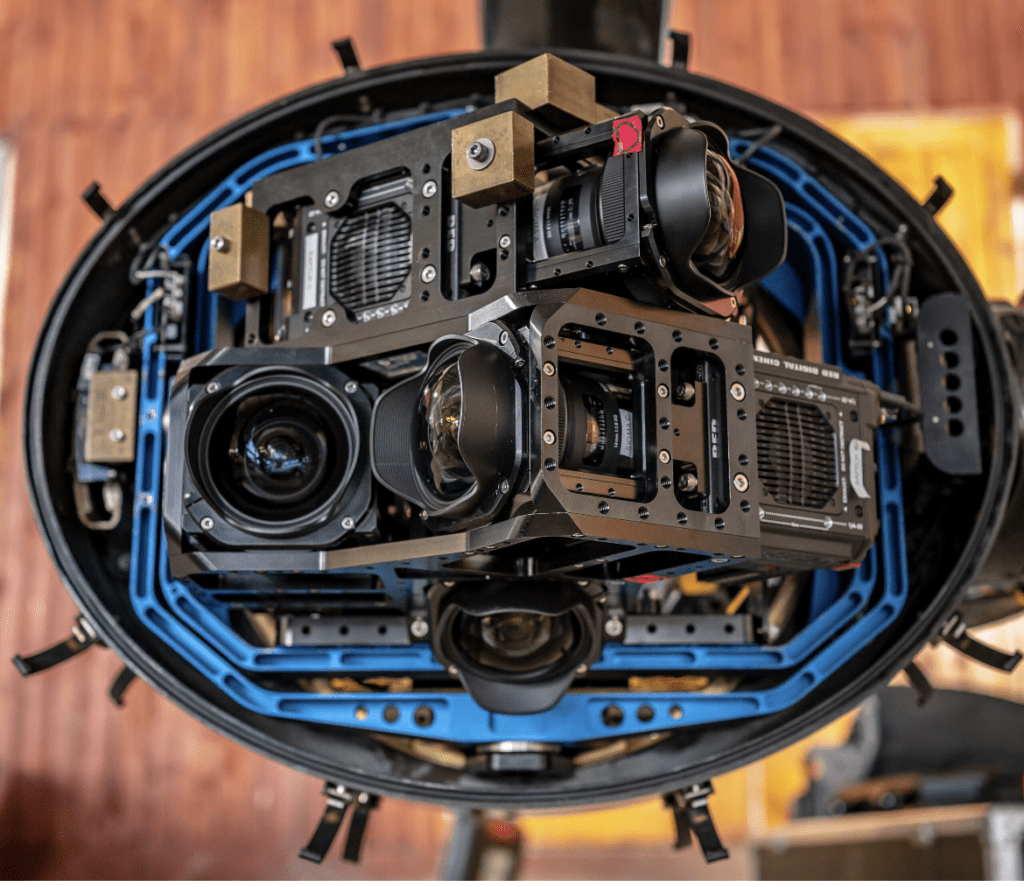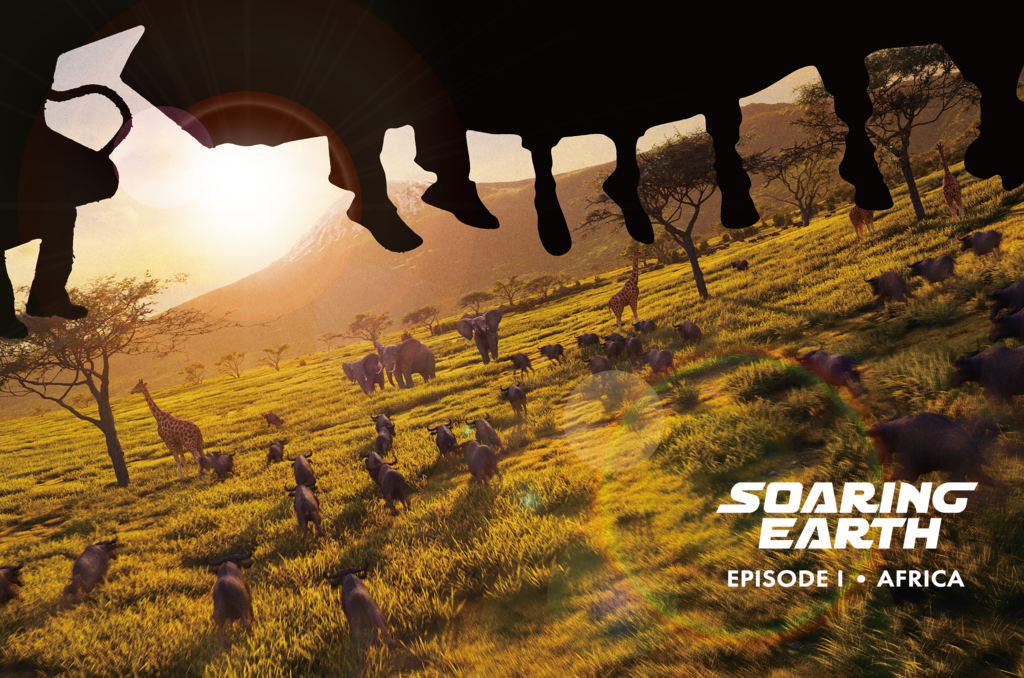Brogent helps steer flying theater content in new directions
by Martin Palicki
Through the course of just over 20 years, flying theaters have become a new genre of attraction – practically in a league of their own. While initially popular in theme parks, they’ve shown success as standalone facilities, particularly in tourism- centric cities. These immersive, media-based attractions combine aspects of giant screen cinema, motion simulation, and 4D experiences.
An assortment of flying theater systems have come to market, providing various methods of placing guests in the middle of a curved or domed screen in order to surround them with the media. While today the flying theater platform is still something of a novelty in its own right, in the long run it is content that will drive repeat visitation. With media-based attractions, it’s natural for content to evolve from being entertainment driven to incorporating educational messaging, which can enhance their value to the local community while still attracting new tourists.
Leading flying theater supplier and media producer Brogent sees great potential in expanding the library of content available for these unique venues. “Flying theaters can not only showcase breathtaking films promoting tourism, but they can also encompass aspects such as culture, geography, and environmental awareness,” says Brogent’s Marketing & Sales Director Stefan Rothaug. And while the network continues to grow, the market is far from saturated. “With over 200 flying theaters around the world, and new ones being built every year, there’s a growing network of facilities interested in new and dynamic media content that both educates and inspires.”
Specialty cinema takes off
Because flying theaters combine the immersion of the giant screen with a ride system that simulates flight, the content has tended to match that concept, providing an experience of hang gliding over beautiful landscapes, albeit often custom-created for each location.
Pursuit, which owns and/or operates multiple flying theaters in locations around the world, has produced a custom film for each new location, following this typical format. In recent years, Pursuit has begun to offer multiple films at each location. For example, guests at FlyOver Las Vegas now have the option of seeing the Las Vegas film, one about Iceland or another about the Canadian Rockies. Digital libraries allow films to be rotated easily and quickly, while encouraging repeat rides and extending length-of-stay.
Brogent has worked with Pursuit and other operators on dozens of flying theater installations and saw firsthand this need for additional content. “We have a strong passion for and deep expertise in flying theaters,” says Rothaug. “Brogent employs a team of specialists working on all the aspects of flying theaters from mechanical motion to video production, playback and audio mixing. We are uniquely positioned to produce specialty content that capitalizes on the flying theater format.”
From vendor to creator
Brogent’s entry into the international flying theater market began in 2013 with the i-Ride system, first installed at Canada Place in Vancouver. Over the ensuing 11 years Brogent has expanded its line to three different flying theater systems and a selection of other rides and simulators. Brogent also began developing content for flying theaters in 2014, through a partnership with Japanese publishing company Kodansha. The result was the launch of the very first Attack on Titan film for flying theaters. In 2017 Brogent installed a flying theater in their headquarters that is open to the public and features their own film Fly High Over Taiwan.
Brogent is now launching the first in a series of 12 films called Soaring Earth, available for distribution to flying theaters and 4D cinemas around the world. The first film, Episode I – Africa, debuted April 22 in Taiwan.
The initial decision to shoot the Soaring Earth series came from Mr. C.H. Ouyang, chairman of Brogent Technologies. Accustomed to traveling the world, his global explorations were halted by the Covid pandemic. During that period, Ouyang discovered the book 100 Places to Go Before They Disappear by Co+Life, and was motivated to bring a similar message to both flying and 4D theaters.
The book showcases locations that are being impacted by climate change, which is precisely what Ouyang and Brogent hope to achieve with the film series. “Everyone should have the chance to witness the Earth’s finest beauty,” states Ouyang.
To achieve Brogent’s goal of combining entertainment with education, the series will include preshows that feature interactive digital previews, allowing guests to gain a preliminary understanding of the cultural ecology and historical changes behind the landscapes featured in the film. After the experience, further information is available about each of the filming locations.
The films will not include text or dialogue, making them ideal for international distribution. “We want people everywhere to experience the beauty of the Earth’s ecology through the engaging experience of flying, ultimately fostering a love for the planet,” explains Rothaug.
Africa was chosen for the first film because so much of the continent remains a mystery to many travelers. “Like a lot of people, I mostly think of Africa as vast savannahs, but in preparing for the film I was reminded that Africa also boasts waterfalls, volcanoes, lakes, jungles, and more,” says Ouyang. “Africa’s landscape is far more diverse and spectacular than most people realize.”
The next two films in the series are already in production, with planning underway for more. According to Rothaug, each film will have two versions, one around five minutes in length and another closer to nine minutes. Films will be optimized for both domed flying theater screens as well in a more traditional configuration for 4D theater screens, making the series available for wider distribution. Brogent’s team of engineers will program the ride system and effects for each venue, and the series will also be available for facilities that do not utilize Brogent hardware.
Theaters in the U.S., Mexico and China have already expressed interest in the series, and Brogent plans to roll out the films to two Taiwan venues owned and operated by the company.
Though Soaring Earth is focused on conservation, Brogent sees the flying theater as a platform for many different kinds of messages in the near future. “Films tailored to Earth’s landscapes are a natural fit for flying theaters,” says Rothaug, “but we also envision content based on everything from Japanese anime to molecular biology. There’s no reason we can’t use this type of attraction to ‘fly into’ art or cellular structures. Now that we have a solid network of venues, the content potential is unlimited.” •
Inside Soaring Earth with Brogent’s Stefan Rothaug
Tell us about Brogent’s motivation for creating the Soaring Earth series.
We feel a sense of urgency surrounding issues of global warming and climate change and aim to achieve multiple goals. We hope to document the Earth’s full range of beauty for people worldwide to experience. We also want to foster a love for the Earth and promote sustainable living by showcasing its beauty. Flying theaters can open a new window to experience the world, achieving the dual purpose of entertainment and environmental education.
What can people expect to see in Episode I – Africa?
Our first film captures the wonders of Africa that are on the verge of disappearing, such as the Nile River, Mount Kilimanjaro, the Okavango Delta, as well as the Great Migration of animals. In addition to focusing on local landscapes and culture, the Soaring Earth series also covers natural disasters like volcanoes and tsunamis, providing viewers with insights and awareness on the realities of nature through the viewing experience.
How will the film be different for flying theaters versus 4D theaters?
Ultimately, the film will be the same. The flying theater provides the most immersive experience, especially when riding within an LED dome. Guests will see a high quality and lifelike 10K image while feeling the gentle breeze of the flight, the mist from waterfalls, and even scents. The 4D cinema provides its own kind of immersion with an array of in-theater effects. Having the film available to both kinds of facilities extends the series to many more venues such as theme parks, zoos, museums, aquariums, and shopping malls.
Do you expect operators will show the entire series in order?
Each film will stand alone. While we think the emotions that come with seeing our beautiful world in this great format will inspire operators to want to show all of the films, we suggest selecting the episodes that really resonate with the guests in each market.
How does this type of content compare to traditional branded IP?
We are strong believers in IP and have produced movies based on Attack on Titan and Ghost in the Shell. Many of our rides around the world are running other IP-based films, but we also believe that the beauty of our planet Earth is timeless and will resonate with a wide audience. If you think about it, the flying theater was really developed for exactly this kind of content.
What is your approach to sourcing material for the films?
Every film is a combination of many sources, including drones, helicopters and CGI. We try to utilize helicopter live action shots as much as possible to provide an authentic connection to our beautiful planet.
Are you anticipating good market response to the conservation messaging?
We believe that through this unique form of edutainment, people can appreciate the beauty of the Earth without feeling pressured and still develop a love for the planet. Based on our experience, flying theater experiences rich in educational content are particularly popular among families. We are not concerned that such experiences will lack appeal to the public. On the contrary, people are more likely to bring their families and friends to experience it together. •











